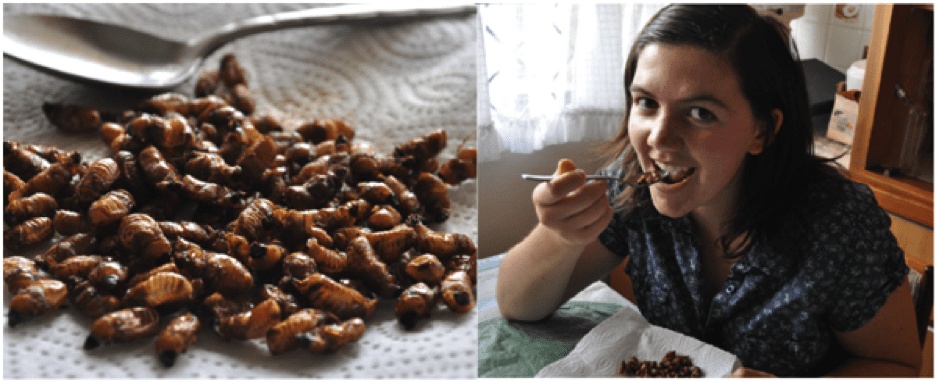In the Disney classic, The Lion King, Simba finds out that Timon and Pumba eat nothing by way of mammalian meat. When he asks what they do eat, they produce a bounty of wriggling beetles and grubs arranged on a leaf. Is this gross, or is it smart-eating?
Entomophagy, or eating insects, has cropped up in the news a lot lately. But why? Why should Timon and Pumba, or better yet humans, be eating a plate of grilled crickets over grilled steak? It turns out the reasons are compelling for your health, the health of the planet, and even your tastebuds!
Health
Need extra protein after squatting at the gym? Consider cricket powder in your protein shake. Crickets have 1.4x more protein per calorie than beef does. They also provide a healthy dose of beneficial fats like omega-3 acids and are high in calcium, iron, and zinc. Furthermore, the proteins found in crickets are more digestible than those in beef, giving you more bang for your buck.
Due to the incredible diversity of insects, more than 1,900 species of insects are known to be edible by humans, meaning you can find the insect with the exact protein-fat-micronutrient ratio needed for your diet. If you subsist on a diet of cereal grains, your diet is most likely low in the amino acid lysine. Many beetle grubs, such as the palm weevil larvae (which my friend swears tastes just like bacon), can help supplement lysine back into your diet. And if you're anemic, crickets have 2.7x more iron than lean beef, and some caterpillars can have up to 10x more iron than lean beef.
Remember mad cow disease? This disease originates from beef that has been in contact with spinal cord or brain tissue. In humans, it can cause neural damage and even death. One of the other benefits of eating insects is the low chance of spreading animal-borne infections to humans. Beef production requires use of antibiotics to cure common illnesses and hormones to increase milk production and produce leaner meat more efficiently. Since insects are so easy to raise at home, no antibiotics or hormones are needed to produce lots of yummy protein in your own closet.
Sustainability
Our obsession with warm-blooded meat is sucking up a lot of resources. Livestock and poultry production both use more water and feed per pound of edible meat, and insects produce much less greenhouse gas emissions than livestock, as you can see in the figure below. Currently, approximately 70% of agricultural land is used for livestock production globally, and the demand for livestock is expected to double from 2000 to 2050 when the human population is expected to reach 9.6 billion.
Insects provide a solution for many of these issues. Because they are cold-blooded, insects can convert more feed into body mass than the warm-blooded animals we consume, such as chicken, pork, and beef.
Insects are small and easy to raise, so they can be produced economically on much smaller farms, making them more environmentally friendly. Livestock, on the other hand, is most economically produced on large farms that cause a lot of environmental problems due to the amount of animal waste they produce.
Water use (or better yet, lack thereof) is one of the biggest reasons that we should be eating more insects. Considering climate issues such as the drought in California, converting our diet to be more insect-based will help decrease our reliance on livestock, including cattle which require 2000x more water per pound of meat than cricket production, as seen in the infographic above.
On a Global Scale
About 80% of the world population supplements insects into their diet in some way. People around the world are eating everything from witchetty grubs in Australia to red ant eggs in Thailand.
It's likely that Westerners don't have a culture of eating insects because we didn't need them in our diets in the past. When our civilization was just forming, Europe had 13 of the 14 now-domesticated mammals, providing early civilizations with leather, meat, and milk. Considering the environmental and health-related benefits of entomophagy, maybe we should rewrite history as we move forward and include insects in our diet where they weren't needed before.
Because of their history entrenched in eating insects, some southeast Asian countries, such as Laos and Thailand are well-primed to start producing insect protein for commercial export, though there is little government regulation or good estimates so far about just how much that could bring in for them financially.
Instead of being disgusted by eating insects, we should see them as an ‘exotic' food, in the same way that Westerners widened our palettes to include raw fish in sushi. Next time you're out, try some roasted chapulines (grasshoppers) in your taco instead of carne asada and enjoy the exotic flavors of Oaxaca, where these grasshoppers are commonly eaten.
On a more personal note
I have sampled a few insects in my life: entomophagy snacks at UGA Entomology outreach events, acetic acid-rich lemon ants in the rainforest, and even a whole plate of sautéed, salted adult beetles or katzos that the Quichua maid at my homestay in Ecuador excitedly made for me.

For this article, I tried to raise and eat insects in a diet that would work even for a lazy graduate student, so I attempted to eat insects in different preparations for one week.
Besides being an incredibly fast-and-easy meal, I found myself enjoying my foray into entomophagy more than I expected. Everything from cricket flour crepes to mealworm lettuce wraps was tasty. I seldom cook meat because of the considerable amount of clean up that takes place after, so mealworms provided a much easier, safer means of eating a dinner high in protein. And if it's good enough for Simba, it's good enough for me. Hakuna matata.
If you are interested in trying out entomophagy for yourself, see some of the following sites:
Six Foods sells fun insect snacks, good for first timers.
Rainbow Mealworms has a certificate to sell mealworms and crickets for human consumption.
Amazon Prime has cricket flour.
Or come try for free at the next Athens Science Cafe this September 24th from 6-8pm at the State Botanical Gardens!
About the Author
 Laura Kraft is a Georgia native, having grown up in Alpharetta, Georgia. She is a joint Bachelor's/Master's student studying aphid endosymbionts under Dr. Kerry Oliver, looking for a PhD program outside the southeast to move to. When not in lab, you'll find her at one of a couple Spanish conversation tables around Athens or improving her amateur photography skills. Laura Kraft is a Georgia native, having grown up in Alpharetta, Georgia. She is a joint Bachelor's/Master's student studying aphid endosymbionts under Dr. Kerry Oliver, looking for a PhD program outside the southeast to move to. When not in lab, you'll find her at one of a couple Spanish conversation tables around Athens or improving her amateur photography skills.
|
About the Author
-
athenssciencecafehttps://athensscienceobserver.com/author/athenssciencecafe/April 17, 2020
-
athenssciencecafehttps://athensscienceobserver.com/author/athenssciencecafe/April 12, 2020
-
athenssciencecafehttps://athensscienceobserver.com/author/athenssciencecafe/April 3, 2020
-
athenssciencecafehttps://athensscienceobserver.com/author/athenssciencecafe/March 30, 2020







